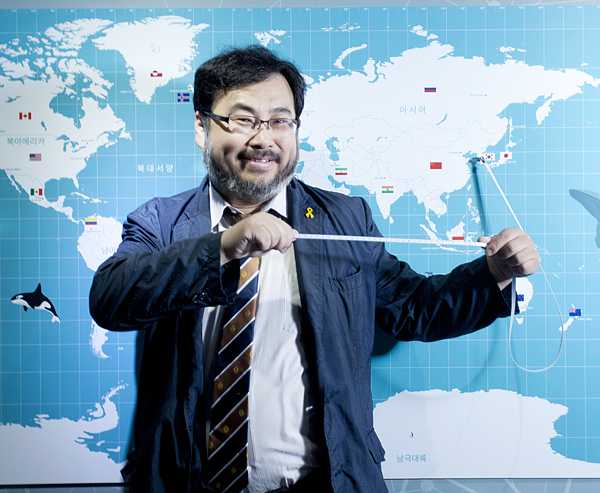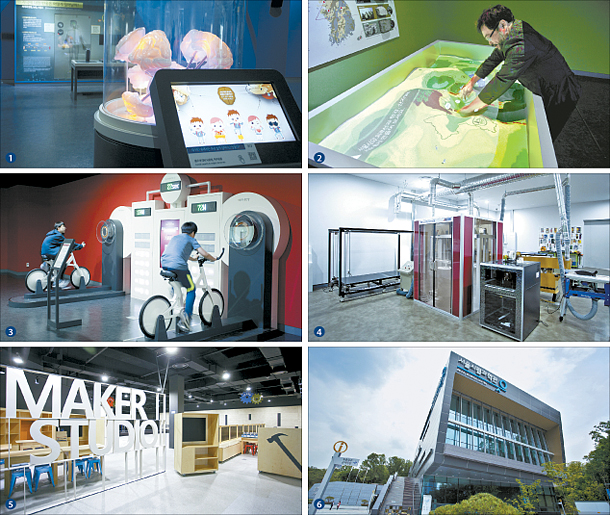Yi Jeong-mo and his palace of discovery : Seoul celebrates the opening of its first municipal science museum

Director Yi Jeong-mo of the Seoul Science Center, which opened on May 19, poses in front of a display that can measure the shortest distances between airports. [JEON HO-SUNG]
Yi Jeong-mo, the director of the Seoul Science Center, which is located in Hagye-dong, Nowon District, northern Seoul, and which opened its doors to the public on May 19, said that a science museum should be a place that raises interesting questions.
The Seoul Science Center is the first municipal science museum in Seoul, and it was built for student’s education in the area of basic science, as well as for the popularization of the subject.
It was first planned in 2011, and went under construction in 2014. However, unlike some science museums, there are no life-sized dinosaur models or anatomical charts of the human body.
Instead, there are piles of sand and water that visitors can actually touch and feel, and cutting-edge devices that take some time to learn how to operate. This museum is the realization of a space where science is not only learned merely with one’s eyes, but with one’s hands.
Located near Chungsuk Park beside Mount Bulam, the museum has a basement level and three floors.
“As there are not many science-related locations in northern Seoul, we built the museum here,” Yi said, who was the director of the Seodaemun Museum of Natural History until June of last year. “When I first came here, I realized that this is the perfect location for a science museum. Visitors can easily access our museum, as there are many households in front, and in the back, there are mountains.”
As you enter the lobby on the first floor, there is a huge hole in the center of the building. There are also exhibition rooms, lecture rooms and office spaces. Floors are named 1/2 floor, 1st floor, √2 floor, 2nd floor, 3rd floor and π floor. In every nook and cranny, there is something to attract visitors’ attention.
A rainbow pops up on a white wall through the glass ceiling with colorful cellophane paper, and chemical symbols of elements like hydrogen (H), ruthenium (Ru) and iron (Fe) are written on lockers. The sides of the building’s escalators are made of transparent glass, so visitors can see how escalators actually work.
The permanent exhibition halls consist of four themes, and the first is Coexistence (survival, environment and architecture), where visitors can find the ‘value of coexistence and consideration of the possibilities of nature and city.’ Displays about which kinds of animals and plants live in the Han River and the concentration levels of particulate matter in the air can also be seen.
The next theme is Survival (the human body, heredity and substance). Here, visitors can learn about DNA, the infection route of pests and mouse-borne diseases, and organs of the human body.
In Circulation (power and energy), visitors can learn about how garbage is processed and about what kinds of energy is used in the city.
Lastly, in Connection (brain science, the universe and mathematics,) visitors can learn about how an airplane flies and how subway trains are powered.

1. A display showing the different functions of the brain. 2. Director Yi Jeong-mo piles up sand on a projection map of Seoul. 3.Students use bicycle pedals to produce energy. 4. The Idea Factory, which is equipped with a large 3-D monitor and scanner. 5. The Maker Studio, where visitors create and display various works. 6. The front view of the Seoul Science Center in Hagye-dong, Nowon District, northern Seoul. [JEON HO-SUNG]
As you enter the first exhibition hall, Coexistence, there are piles of sand in one corner. A map of Seoul is projected onto the sand and visitors can pile up sand or make mountains or rivers wherever they want. If one makes a hole in the sand, water is projected into the hole.
On another side of the room, there is a projection of Mount Bukhan. When a visitor stands in front of a camera, a projection of weasels, elk and squirrels passes by.
“In the exhibition rooms, there are no signs that read ‘don’t touch’. Visitors can physically experience everything they see and can actually learn,” said Yi.
In the Survival hall, there is a microscope through which visitors can see the structure of skin. In the Connection hall, there is a machine that shows the locations visitors have been to when they touch their transport card on the card reader. There is also a 3-D room where visitors can feel like they are in outer space, and can then observe various places such as the International Space Station.
On the 3rd floor, visitors can ride bicycles and learn how energy is produced. They can experience the correlation between pressure and power production by pushing air pumps.
One of the main roles of the Seoul Science Center is to be a classroom outside school, says Yi. Besides exhibition halls, there are also lecture rooms and chemistry, physics and biology labs. There is also a small library that only consists of science books.
“It is not easy for regular schools to be equipped with cutting-edge science instruments,” said Yi. “We are planning to open up labs to any students or teachers who want to use them.”
Maker Studio is a place within the museum where creative works are produced, displayed and used to teach visitors. As of now, there is a carpentry class for adults taking place here. On the rooftop of the building, there is a deck where people can relax, and where they can observe the stars.
In the summertime, students will also be able to take overnight trips and stargaze on the roof.
To celebrate the opening of the Seoul Science Center, there was a science festival from May 19 to 21.
A moveable astronomical observatory called Star Car was installed, and visitors were allowed to fly drones and take part in science lecture programs.
“Science education in schools has taught the students answers, but a scientist is a person of constant failure,” said Yi. “I hope to make this a place of discovery through failure, and a place where we can teach them the joy of science.”
After having a look around the museum, JoongAng Sunday, an affiliate of the Korea JoongAng Daily, sat down with director Yi for an interview.
Q. Are some exhibition halls hard for students to understand?
A. This museum is a place for both adolescents and adults. The National Children’s Science Center, which is a kids-friendly science center, is expected to open soon in September. To differentiate from that museum, we stepped up our museum’s overall level of difficulty. There will be 19 docents who will assist visitors and help them with unfamiliar devices.
Does it take a lot of time to look around one exhibition hall?
One day might not even be enough since visitors can actually experience the devices and work with friends. I wish this museum will become a place where students can freely drop by after school, or come back any time they feel like coming.
Did you refer to foreign science museums when building this one?
We looked into some science museums in England, and the Exploratorium in San Francisco. However, we referred to Korean scientists the most, as our main target was to create a space that can provide scientific content for the people of Seoul.
Do you ever worry about some visitors breaking the devices in the museum?
I have that in mind. I think things will soon start to break. That’s why there is a room that can be used to repair broken devices. There is a huge 3-D printer, high definition 3-D scanners and other devices. Our staff can repair devices and visitors can see the whole process. Also, visitors can also use the devices.
Why are there spaces that are still empty?
We are planning to use those spaces based on the needs of students, teachers and the community. Near our museum, there are about 35 schools. Science museums should be like an open classroom - a space where the students can freely come in and enjoy it.
Will there also be classes for adults?
We have lectures for adults. Starting last month, we had lectures for parents, and almost 30 people joined the classes. I think as people become older, there are fewer chances to encounter science. When you learn science, it is not only good for your children’s education, but also good for yourself. I want to provide that feeling of excitement to adults, as well.
BY LEE YOUNG-HEE [jeon.sohyun@joongang.co.kr]
The entrance fee for the museum is 1,000 won ($0.89) for children and teenagers, and 2,000 won for adults. Entrance is free until the end of May.










with the Korea JoongAng Daily
To write comments, please log in to one of the accounts.
Standards Board Policy (0/250자)